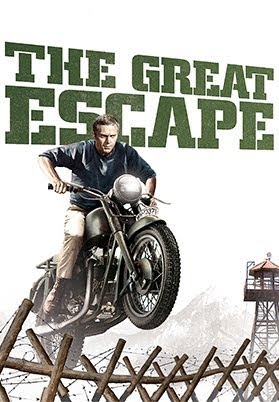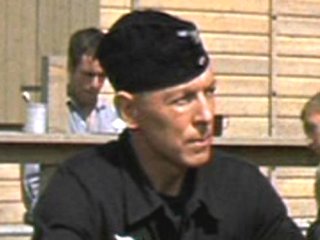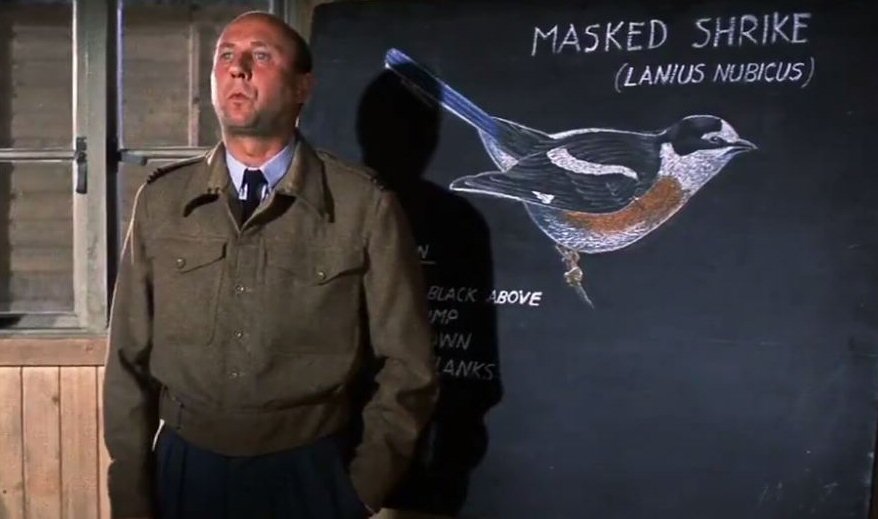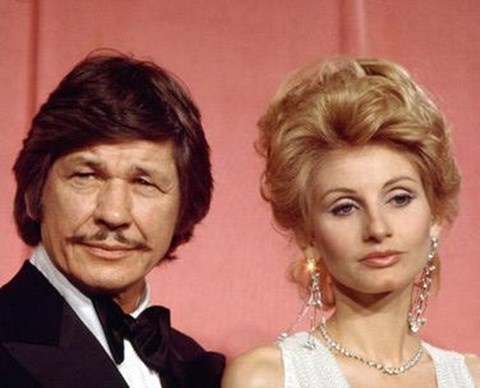

In World War Two Stalag Luft III was an enormous POW camp in Germany, encompassing 59 acres surrounded by over five miles of perimeter fencing and housing some 10,000 Allied servicemen of the Fleet Air Arm. Renowned author Paul Brickhill wrote the book from which this film is taken. He was imprisoned at Stalag Luft III after being shot down in his Spitfire over Tunisia in March 1943. While in the camp he helped with escape preparations.

Author Paul Brickhill
Nearly every incident depicted in the movie actually happened with the exception of the Steve McQueen motorcycle chase. There really was a ‘cooler king’, a Flight Lieutenant named Barry Mahon. He declined his chance to escape with the others, a decision that probably saved his life. As a technical advisor on the picture, Mahon befriended McQueen who included much of the man’s persona in the Hilts character. The motorbikes McQueen insisted upon using included a 1962 Thunderbird used for the ‘jumping the fence’ stunt. He attempted that particular stunt (a 60-foot jump) himself but crashed. A stunt rider then performed it safely. Incidentally, when you watch Hilts being pursued by a German motorcycle rider you are watching McQueen chasing himself. He did the riding for both characters. In fact, he only agreed to sign on for the picture at all if his character could star in a motorcycling scene or two.

McQueen, true to form, held up production until his character was given more to do and say. He wanted this to be his movie, so when his character disappeared from the screen for nearly 30 minutes in the middle of the picture he refused to return to the set until Hilts was somehow inserted into that 30 minutes. His demands aggravated the director to the point where he was willing to write Hilts out of the picture altogether, but the heads at United Artists considered McQueen essential to the film’s success and coughed up extra money for rewrites. He rarely mingled with the rest of the cast and stayed with his wife and family in a chalet nearby, from which he would travel each day to the set in a chauffeur-driven limousine.

Hans Messemer as ‘The Kommandant’

Til Kiwe as Frick
German actor Hans Messemer played the Commandant at Stalag Luft III. Back in 1942 he was an 18 year-old soldier in the Wehrmacht when he was sent to the Russian Front for disobeying an order. He was captured at Stalingrad and became a POW in a Russian camp. In 1945 he managed to escape and trudged hundreds of miles back home to Germany. Another German actor, Til Kiwe, played Frick. In real life he was a paratrooper who was captured by the Americans in North Africa in 1943 and placed in a prison camp in the USA. He made no fewer than seventeen escape attempts throughout the remainder of hostilities.

James Garner as ‘Hendley, the Scrounger’
James Garner’s character, Hendley the Scrounger, was loosely based on Airman Marcel Zillessen, a prisoner who gathered necessary pen, ink and paper for the escape documents by writing love letters for the German guards. Fortunately for Zillessen, he was one of the last out of the tunnel and was at once arrested by prison guards and returned to the compound. Donald Pleasance plays the forger, Colin Blythe. The real forger in Stalag Luft III was a prisoner named James Hill. In 1966 he would direct the hugely successful movie Born Free. Obviously, he neither went blind, nor was he shot as depicted here. Pleasance, on the other hand, was himself a pilot in the RAF during the war. He was shot down, captured and later tortured by the Gestapo. Initially, director John Sturges rejected out of hand his offer to provide input into the authenticity of the Stalag set, but he later learned of Donald’s war record and utilised his knowledge on the subject for the remainder of the shoot.

Donald Pleasance as ‘Blythe, the Forger’

James Hill during WW2
Charles Bronson’s character, Danny the Tunnel King, is a composite of five specialist tunnelling experts, three of whom were captured and shot. The fourth, Wally Floody, was actually transferred to another camp prior to the breakout. He became a valuable consultant on The Great Escape. Before turning to acting Bronson had worked as a coal-miner and suffered from claustrophobia, just as his character does in the movie. When David McCallum snared the part of Ashley Pitt, he decided to bring his wife, actress Jill Ireland, to the shooting location. There she mingled with the rest of the cast and met Bronson who jokingly warned McCallum that he would one day steal his wife away from him. In 1967 he did. A year later the couple were wed and remained together until Jill’s death from cancer in 1990.

‘The Tunnel Kings – Danny and Willie’
Charles Bronson & John Leyton

McCallum as Ashley Pitt

Jill Ireland and David

Bronson and Ireland
McCallum’s character, Pitt, was based on Peter ‘Hornblower’ Fanshawe. It was he who figured out how to disperse the sand from the tunnels. And he was not shot at the railway tracks as shown here. Like Floody, he was luckily transferred to another camp before the escape took place. Angus Lennie plays Ives the Mole who is shot to death on the wire during a crazed escape bid. In real life he was H W ‘Piglet’ Lamond. He managed to escape in the big breakout, was quickly recaptured – and survived the war. The real-life Squadron Leader Roger Bushell, called Bartlett ‘Big X’ here, and played by Richard Attenborough, was a Spitfire pilot and an Olympic skier prior to the war. The facial scar worn by him in the movie is authentic, the real Bushell having received it in a pre-war skiing accident.

Angus Lennie as ‘Ives, the Mole’

Gordon Jackson & Richard Attenborough
as ‘Mac’ and ‘Big X’

Nigel Stock as Cavendish
Nigel Stock plays Cavendish, the escapee we see interrogated by the Gestapo. Since he is later shot as one of the fifty murdered on Hitler’s orders we can be forgiven for assuming his interrogation was probably a concocted scene, yet that is not so. The real Cavendish was indeed murdered. However, that was not before he had described his quizzing by the Gestapo to a fellow escapee who survived. The interrogation scene in the picture is, therefore, true to life. The fifty doomed prisoners died in small groups at different times and at different locations. The scene in the movie where they are all herded from a truck and machine-gunned is a fabrication. After the war, twenty-one of their murderers were tried and themselves executed, eleven others suicided, another died at the hands of the Russians and a further seventeen received lengthy prison terms.
Only three of the 76 escapees, two Norwegians and a Dutchman, made it all the way home. In the movie James Coburn plays the Dutchman, but for some reason the producers changed him into an Australian. One can only assume that the producers felt there was likely to be more Australians than Dutch paying to see the movie. Whatever the reason, Coburn promptly assailed us with one of the worst Australian accents ever put on film. Although there were Americans in the camp when preparations began for the escape, they had all been transferred by the time it actually took place. The nationalities of the 50 executed were as follows: 21 British, 6 Canadians, 6 Poles, 5 Australians, 3 South Africans, 2 New Zealanders, 2 Norwegians, 1 Belgian, 1 Czech, 1 Frenchman, 1 Greek and 1 Lithuanian. The 23 survivors of the escape: 15 British, 2 Canadians, 2 Czechs, an Australian, a Frenchman, a New Zealander and a Rhodesian.

Lawrence Montaigne as Haynes

James Donald as ‘SBO’
James Coburn as ‘Sedgwick’
As of July 2016, only three of the featured players of The Great Escape are still living – David McCallum (83), John Leyton (77), who played Willie ‘the Tunnel King’ and Lawrence Montaigne (85), who played Haynes:
Year of death Age Actor Role
1966 42 Robert Graf Werner ‘The Ferret’
1980 50 Steve McQueen Hilts ‘The Cooler King’
1986 66 Nigel Stock Cavendish ‘The Surveyor’
1990 66 Gordon Jackson Mac
1991 67 Hans Messemer Von Luger ‘The Kommandant’
1993 76 James Donald Ramsey ‘The Senior British Officer’
1995 75 Donald Pleasance Blythe ‘The Forger’
1995 80 Til Kiwe Frick
2002 74 James Coburn Sedgwick ‘The Manufacturer’
2002 74 Robert Desmond Griffith ‘The Tailor’
2003 81 Charles Bronson Danny ‘The Tunnel King’
2008 76 Jud Taylor Goff
2014 84 Angus Lennie Ives ‘The Mole’
2014 86 James Garner Hendley ‘The Scrounger’
2014 90 Richard Attenborough Bartlett ‘Big X’

Director John Sturges
One final note: At one point the distributors (United Artists) became overly concerned that The Great Escape had no women in it! They proposed to Sturges that Ashley Pitt (David McCallum) should be cradled in the lap of a beautiful female passenger in a low-cut blouse as he lay dying on the railway tracks. They further proposed that a ‘Miss Prison Camp’ contest be held nearby in Munich to select an appropriately big-bosomed blonde for the role. Sturges was indignant and would have none of it.

In James Garner’s autobiography The Garner Files he writes about the making of TGE.
McQueen was going to walk off the production as reported but Garner & James Coburn who both friendly with Steve went to see what the problem was & attempt to solve it.
Garner did not care for Charles Bronson at all. He found him pugnacious & with a chip on his shoulder all the time.
It has been a long time, but I always thought Grace Kelly’s role in
“Rear Window,” was “filler” quality; only to have a good looking woman.
I couldn’t agree with you more, Sheila. She was there for the male part of the audience to gawk at. I confess – I gawked. I do everytime I see the picture (which is not one of my favourites, by the way). Too many flat spots, but then I have never had much time for Hitchcock as a director anyway. Not that he is alone in that regard. Blake Edwards and Baz Luhrmann leave me cold as well.
Hurray for Sturges not bowing to the demands of the distributors!
Yes, about once in every blue moon a movie gets made that does not have a female in it sheerly as a love interest. ‘The Great Escape’ and ‘Lawrence of Arabia’ are two I can think of off the top of my head, but there aren’t too many. Funny thing is, both pictures made a bundle.